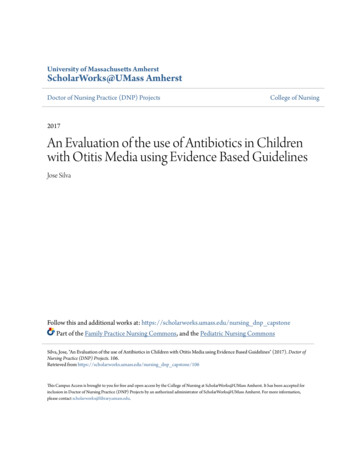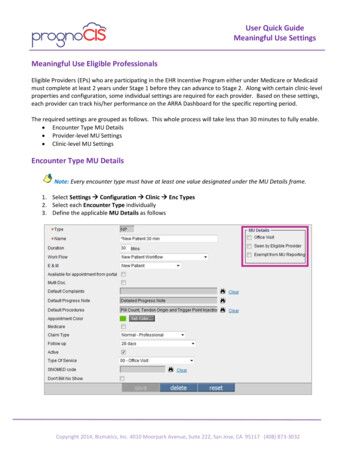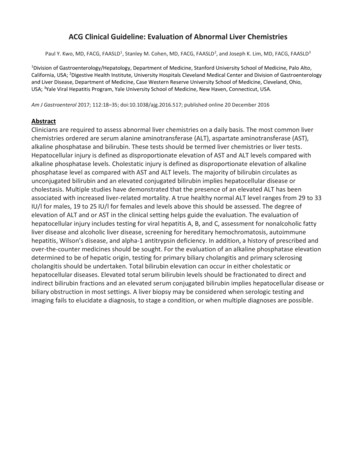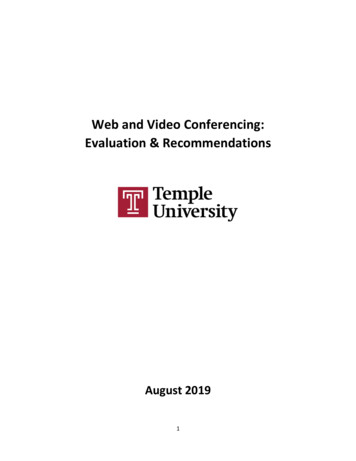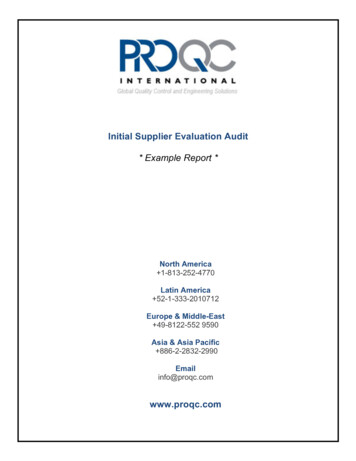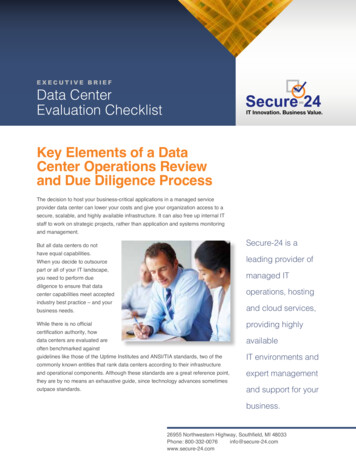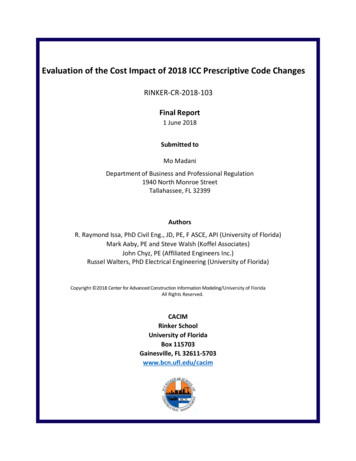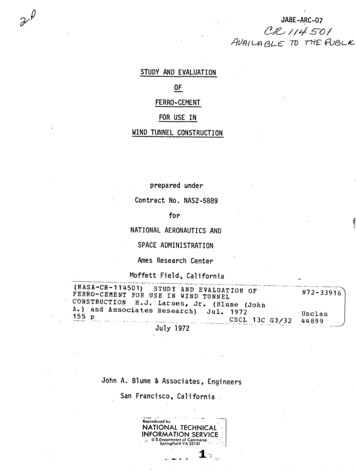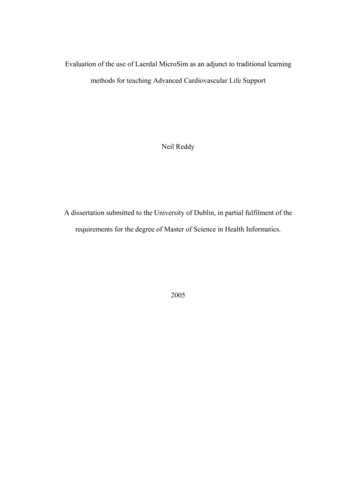
Transcription
Evaluation of the use of Laerdal MicroSim as an adjunct to traditional learningmethods for teaching Advanced Cardiovascular Life SupportNeil ReddyA dissertation submitted to the University of Dublin, in partial fulfilment of therequirements for the degree of Master of Science in Health Informatics.2005
DeclarationI declare that the work described in this dissertation is, except where otherwise stated,entirely my own work, and has not been submitted as an exercise for a degree at thisor any other university.Signed:Neil Reddy2
Permission to lend and/or copyI agree that the Trinity College Library may lend or copy this dissertation uponrequest.Signed:Neil Reddy3
AcknowledgementsI would like to thank the ACLS community in Ireland who gave their time andresources to the implementation of this study – Fiona Barton (Bons Secours Hospital,Tralee), Celine McPhillips and Clodagh Thornton (Beaumont Hospital, Dublin),Glenna Woods (St. Vincent’s University Hospital, Dublin), Tom Giffney (ACLSTraining Services, Dublin), Gerry Allen (South Infirmary-Victoria Hospital, Cork),Liam Plunkett (Adelaide, Meath and National Children’s Hospital, Dublin)I would like to thank Laerdal Corporation for the provision of the software andlicences required to run the study, in particular Dave O’Connor (Cardiac Services,Dublin) and Martin Clarke (Laerdal UK)I would also like to thank my supervisor, Jane Grimson, and Mary Sharp, both of theDepartment of Computer Science for their invaluable advice and expertise during thepreparation of this dissertation.4
List of figures used in this document (with page numbers)Figure 1 VT/VF Algorithm (page 11)Figure 2 Typical ACLS Training Station (page 13)Figure 3 Running an ACLS scenario (page 15)Figure 4 Intubation Training Simulators (page 22)Figure 5 IV Cannulation Training Simulators (page 22)Figure 6 Simulated patient using actor (page 23)Figure 7 Laerdal MicroSim (page 24)Figure 8 Web-based ACLS simulator (page 24)Figure 9 Simbionix Angiography trainer (page 25)Figure 10 Simbionix Laparoscopy trainer (page 26)Figure 11 Laerdal Megacode Kelly patient simulator (page 28)Figure 12 Laerdal MicroSim Pre-hospital simulator (page 32)Figure 13 MicroSim Interface (page 33)Figure 14 MicroSim feedback screen (page 37)Table 1 Simulation Technologies (page 21)Table 2 MicroSim Scenarios and ACLS Core Cases (page 36)Chart 1 Internet Connection (page 52)Chart 2 Operating System (page 53)Chart 3 Use of educational resource by computer literacy (page 54)Chart 4 Educational resources used (page 54)Chart 5 Computer-literacy in test and control groups (page 55)Chart 6 MicroSim enjoyment and computer-literacy (page 55)Chart 7 Ease of installation and computer-literacy (page 56)Chart 8 Ease of navigation and computer-literacy (page 56)5
Chart 9 Enthusiasm for Self-directed Curriculum and computer-literacy (page 57)Chart 10 Perceived important parts of ACLS simulator (page 58)Chart 11 Satisfaction with important parts of MicroSim program (page 58)Chart 12 Action choices in MicroSim scenarios (page 59)Chart 13 MicroSim consistency with real-world (page 59)Chart 14 Overall impression of MicroSim program (page 60)6
SummaryThis dissertation describes the current state-of-the-art in simulation technology usedin healthcare education. A research study is also presented, describing the Evaluationof Laerdal MicroSim as an adjunct to traditional learning methods for teachingAdvanced Cardiovascular Life Support. The objectives of the research were toelucidate any difference in objective outcomes (multiple choice examination scoreand skills assessment score) or subjective outcomes (candidate satisfaction with thecourse and program) between a test and control group. The test group used theMicroSim program for an amount of time of their own choice in the week before anACLS course in addition to the normal textbook study, pre-course MCQ and rhythmevaluations. Both groups were chosen at random from the list of candidates for 5ACLS Provider courses in Ireland, between June and August 2005. In total, 78candidates took part in the study (39 test, 39 control). No statistically significantdifference was found between the MCQ result (93.49 and 92.72, p 0.24) and theskills assessments (98.36 and 97.13, p 0.11) for the test and control groups,respectively. Subjective outcomes tended to be better in the test group but were notstatistically significant. Overall, the use of the program was well received in terms ofenjoyment, ease of installation and relevance to the ACLS course. Those with betterperceived computer literacy found the program easier to use and got more enjoymentout of it. 84% of the test candidates enjoyed the program and 74% would recommendthe program to a friend. 61% expressed an interest in receiving ACLS Certification byusing a self-directed curriculum of which the MicroSim program would form thebiggest part. This study, although of small sample size, does show that screen-basedsimulators are generally well-received by ACLS candidates of varying computerliteracy.7
AbstractOBJECTIVES: to evaluate the difference made to students’ outcomes by usingLaerdal MicroSim ACLS simulator in addition to traditional learning methods prior toan ACLS course. METHODS: 78 candidates (39 test, 39 control) were chosenrandomly from the candidate list of 5 ACLS courses. Test candidates received theMicroSim program for one week prior to taking the ACLS Provider course. Bothgroups completed the normal textbook study and pre-course MCQ and Rhythmrecognition tests. Objective outcomes were Post-Course MCQ result and MegacodeSkills evaluation score. Subjective outcome was candidate satisfaction assessed bypost-course questionnaire. The ACLS course was conducted as normal and theinstructors were blinded as to the test status of the candidates. OUTCOMES:There was no significant difference between the test and control groups in terms ofMCQ result (93.49 and 92.72, p 0.24) or skills assessments (98.36 and 97.13,p 0.11). Although the subjective outcomes tended to be better in the test group, theresults were also not statistically significant. Overall satisfaction with the ACLScourse was very good. Overall satisfaction with the MicroSim program was also good,but was influenced by the perceived computer-literacy of the test participants.CONCLUSIONS: screen-based simulators such as Laerdal MicroSim are wellreceived by ACLS candidates and do not seem to have any negative impact on theskills or knowledge of the candidates when used as an adjunct to the textbook fortraditional ACLS courses.8
PageTable of ContentsAcknowledgementsivList of figures and tablesvAbstractviChapter 1 – Introduction1.1 Background11.2 Objectives21.3 Dissertation Structure3Chapter 2 – State of the Art2.1 ACLS52.1.1 History52.1.2 General Principles72.1.3 The 2-Day ACLS Course122.1.4 Challenges172.2 Simulation Technologies192.2.1 History192.2.2 Benefits192.2.3 Techniques212.2.4 Laerdal MicroSim30Chapter 3 – Study Design3.1 Objective Outcome Evaluations403.1.1 MCQ403.1.2 Skills Assessments413.2 Subjective Outcome Evaluations413.2.1 Pre-Course Questionnaire419
3.2.2 Post-Course Questionnaire43Chapter 4 – Implementation4.1 Logistics454.2 Difficulties46Chapter 5 – Evaluation5.1 Objective Evaluations495.2 Subjective Evaluations50Chapter 6 Conclusions and Future Work60References61Appendix 1 – Questionnaires63Appendix 2 – Glossary of terms and abbreviations74Appendix 3 – Skills Assessment Sheets76Appendix 4 – Sample MCQ Question78Appendix 5 – AHA ACLS Algorithms7910
11
Chapter 1 - Introduction1.1 BackgroundThis dissertation describes an evaluation of a commercially-available computerprogram (Laerdal MicroSim), designed to simulate the management of critically-illpatients in a hospital environment as part of the ACLS (Advanced CardiovascularLife Support) educational program for healthcare professionals. The preparation workwas carried out between October 2004 and June 2005, while the actual evaluationtook place between June 2005 and August 2005.The ACLS course was introduced in 1974 by the American Heart Association (AHA)as a way to disseminate the latest evidence-based guidelines and to standardise thecare of critically ill patients (1). It has since been adopted in over 30 countries. Thefirst courses were taught in Ireland in 1999 by the Irish Heart Foundation (IHF) underofficial license from the AHA.The course is an intensive, 2-day, instructor-led course, taught by a combination oflectures, small-group discussions and hands-on practical training. The official AHAtextbook is a comprehensive guide to the theory of managing a cardiac arrest usingevidence-based guidelines and is provided to each candidate and few weeks before thecourse. Although, anecdotally, the candidates are generally happy with the way thecourse is taught, the large amount of information presented in a short time allowsinadequate time for practice of scenario-management and skills.12
The solution offered by Laerdal MicroSim is a multimedia, screen-based computersimulator. This program presents the candidates with a cardiac emergency scenario,allowing them to choose interventions with realistic results, giving the candidatefeedback at the end of the scenario. The program can be used as an adjunct to thetextbook prior and after to the course or may form part of a self-directed ACLScertification curriculum, which is in the implementation process in the United States.1.2 ObjectivesThe objectives of the research part of this dissertation are To evaluate the difference made by using the program prior to an ACLScourse in terms of the objective course outcomes of a multiple choice questionexam (MCQ) result and Skills assessments. To evaluate candidate satisfaction and enthusiasm for this method of learningin terms of their subjective opinions regarding the program and the courseitself.13
1.3 Dissertation StructureChapter 2 describes the State-of-the-art of both ACLS and of computer simulationtechnologies as applied to healthcare.Chapter 3 describes the design of the study and the methods used for recruiting,informing and evaluating the participants.Chapter 4 details the implementation of the study. It also describes the difficultiesencountered with logistics and course heterogeneity.Chapter 5 presents the results of the study under the headings of objective outcome(MCQ and Skills Assessments) and subjective outcome (participant satisfaction andopinion). The methods used for data analysis are presented in this chapter.Chapter 6 contains the author’s conclusions drawn from the information gathered inthis study. It also presents a discussion of the importance of this data for future ACLSSimulation.Appendices – this section contains the original Questionnaires used in the study, aglossary of terms and abbreviations, sample MCQ and Skills Assessments and theofficial AHA ACLS Algorithms.14
CD-ROM – the CD provided in the inside cover of the dissertation is a demonstrationcopy of Laerdal MicroSim, which will give the user 2 hours use of the program andone cardiac emergency scenario.15
Chapter 2 - State-of-the-art2.1 Advanced Cardiovascular Life Support (ACLS)2.1.1 HistoryThe American Heart Association guidelines for Advanced Cardiovascular LifeSupport were developed during the 1970s and have been revised on a number ofoccasions since then, as new evidence-based recommendations emerge, with a majorrevision in 2000. (2) The guidelines are updated every couple of years after a majorAHA conference at which the latest research trials are presented and debated bypanels of experts, following rigorous evidenced-based guidelines. The nextconference takes place in Houston, Texas in November 2005.There are International Training Centres in over 33 countries, including Ireland – TheIrish Heart Foundation. The International Training Centres teach the ACLS guidelinesas issued by the AHA but are allowed some flexibility in terms of local practices e.g.availability of different drugs or procedures. Certification in ACLS is issued by thelocal training site under licence from the AHA. The ACLS certification is recognisedin all countries that follow the AHA guidelines.Some European countries (including UK) have adopted the guidelines issued by theEuropean Resuscitation Council (ERC) – developed separately to the AHAguidelines. Although the actual guidelines differ in only minor ways, certification byone organisation is not recognised by the other. The International Liaison Committee16
on Resuscitation (ILCOR) was formed in 1992 to provide a forum for liaison betweenprincipal resuscitation organisations worldwide.Last year 1900 healthcare professionals received ACLS certification in Ireland. Thereare over 18 licensed training sites in Ireland, mostly based in hospitals. The coursemay be taken by any healthcare professional but the majority of candidates come fromcritical care areas – doctors, nurses, emergency medical technicians (EMTs) andcardiac technicians. Certification is a requirement of some postgraduate trainingprogrammes, including intensive care (ICU/CCU) nursing diploma, specialist registrartraining (SPR) and general professional training for doctors (GPT). Candidates mustretake the course every 2 years to maintain certification.Trainee doctors receive full funding for the cost of the course (350-500 Euro), nursesand cardiac technicians receive partial or full funding depending on their employer,while EMTs usually have to pay the full cost.17
2.1.2 General principlesResuscitation guidelines – including AHA and other models – are based around theevidence that more people can survive sudden cardiac arrest when a particularsequence of actions are performed as rapidly as possible – The Chain of Survival.The Chain of Survival (3) is1. Early access to the Emergency Medical System (EMS)2. Early Cardiopulmonary Resuscitation (CPR)3. Early defibrillation4. Early ACLS1. Early Access to EMS. Persons discover
Figure 11 Laerdal Megacode Kelly patient simulator (page 28) Figure 12 Laerdal MicroSim Pre-hospital simulator (page 32) Figure 13 MicroSim Interface (page 33) Figure 14 MicroSim feedback screen (page 37) Table 1 Simulation Technologies (page 21) Table 2 MicroSim Scenarios and ACLS Core Cases (page 36) Chart 1 Internet Connection (page 52) Chart 2 Operating System (page 53)


